Exploring North American Woodpeckers: Habitat and Behavior
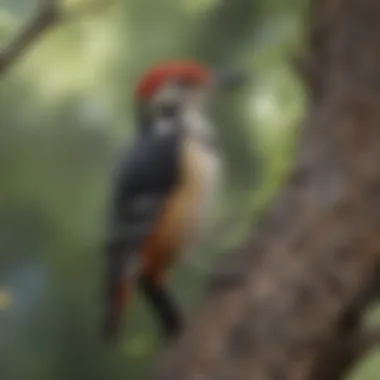
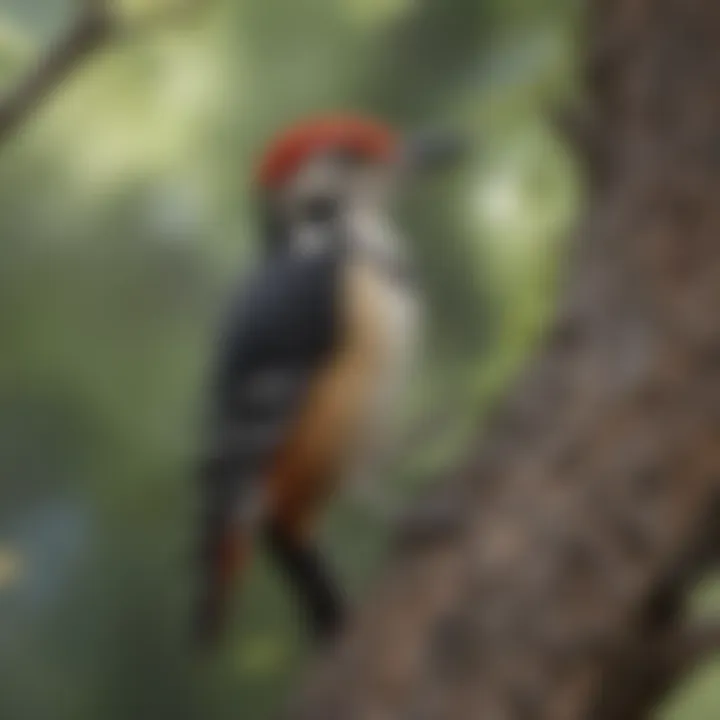
Overview of the Topic
Woodpeckers are among the most intriguing avian species found in North America. Their distinctive drumming sounds and unique adaptations make them an integral part of forest ecosystems. These birds are not just remarkable for their physical attributes but also for their critical ecological roles. By excavating tree bark and creating nesting cavities, woodpeckers contribute to the well-being of various other species. They support biodiversity and help regulate insect populations, making them a vital component of forest health. Understanding woodpeckers, their habitats, and behaviors is essential for promoting conservation efforts.
Importance of Woodpeckers
Woodpeckers help maintain the structure of forests. Their foraging can significantly reduce insect infestations, which can harm trees and disrupt the ecosystem. Various species of North American woodpeckers, including the Downy Woodpecker and the Pileated Woodpecker, exhibit remarkable adaptability to their environments. They inhabit a range of ecosystems from deciduous forests to urban areas.
This article aims to offer a comprehensive overview of North American woodpeckers. We will look closely at their behaviors, the places they call home, and the challenges that threaten their existence. Understanding these aspects is crucial for effective conservation strategies, as the pressures facing these birds grow more significant in an ever-changing environment.
Current Status and Challenges
The current state of woodpecker populations across North America is of significant concern. While some species flourish, others are witnessing alarming declines. Habitat loss due to urbanization, logging, and forest fragmentation are leading causes of this decline. Furthermore, changes in climate have disrupted their feeding patterns and reproductive behavior, complicating the situation further.
Threats to Woodpecker Species
- Habitat Destruction: One of the major threats is the loss of forest habitats due to human activities. This not only affects woodpeckers but also countless other species that rely on the same ecosystems.
- Pesticide Use: The use of pesticides in agriculture can significantly decrease the availability of insects, leading to food shortages for woodpecker species.
- Climate Change: Altered weather patterns can impact their breeding grounds and the availability of food sources.
Overall, the intricacies of these challenges require urgent attention from conservationists and policymakers.
Sustainable Solutions
To combat these issues, several sustainable practices can be implemented. Encouraging responsible forestry and maintaining suitable habitats can yield positive results for woodpecker populations.
Effective Conservation Strategies
- Habitat Restoration: Reforesting areas that have been depleted can create more feeding and nesting opportunities.
- Community Education: Raising awareness about the significance of woodpeckers can foster community support for conservation initiatives.
- Legislation and Protection: Enforcing laws that protect these birds and their habitats can help mitigate some of the threats they face.
"Preserving the habitats of North American woodpeckers is not just about saving a single bird species; it is about maintaining the health of entire ecosystems."
Such initiatives can serve as a model for other species facing similar threats, creating a ripple effect that can enhance biodiversity.
Impact and Importance
The decline of woodpecker populations would have extensive repercussions on their ecosystems. Losing these birds would disturb the balance of the forest environment and impact species that depend on them.
Emphasizing conservation methods is essential for the survival of woodpeckers and the many services they provide. Communities need to understand the importance of sustainable practices, as the health of these birds directly reflects the health of our forests.
Encouraging conservation efforts and promoting awareness can have a long-term influence on the future of these remarkable birds and their habitats.
Preface to North American Woodpeckers
North American woodpeckers are a captivating group of birds that play a vital role in the ecosystems they inhabit. They are found across various habitats, from dense forests to suburban areas. Understanding woodpeckers is crucial for several reasons: their ecological significance, their unique behaviors, and the challenges they face due to environmental changes.
These birds are not only important for their role in pest control but also act as ecosystem engineers. By creating nesting cavities in trees, they provide habitats for other species. Their feeding habits contribute to the health of forest ecosystems, making them integral to maintaining ecological balance.
Woodpeckers exhibit a variety of behaviors that are fascinating to study. From their distinctive drumming sounds used for communication to their intricate mating rituals, these behaviors reveal much about their way of life. Additionally, their adaptations for foraging offer insight into how they interact with their environment and ensure their survival.
However, North American woodpeckers face numerous threats that jeopardize their populations. Habitat destruction, climate change, and competition with other species are significant issues impacting their numbers. Recognizing these challenges is essential for conservation efforts. Protecting woodpecker habitats and promoting awareness of their importance in ecosystems is key to ensuring their survival.
This article seeks to provide a comprehensive exploration of North American woodpeckers. Each section will delve into aspects such as their taxonomy, physical traits, behaviors, habitats, and current conservation status. By the end of this exploration, readers will gain a deeper understanding of these remarkable birds and the pressing need to protect them and their habitats.
Taxonomy and Diversity of Woodpeckers
Understanding the taxonomy and diversity of woodpeckers is crucial in appreciating their ecological roles and conservation status. Taxonomy provides a framework for identifying and classifying species, which is essential for conservation efforts. The diversity among woodpecker species tells us about the different habitats they occupy and their roles in these environments. By examining this diversity, we can gain insights into how these birds interact with their ecosystems and the pressures they face.
Classification of Woodpeckers
Woodpeckers belong to the family Picidae. This family is a part of the order Piciformes, which includes various other birds such as honeyguides and toucans. Within the Picidae family, woodpeckers are further divided into genera and species. Factors like geographic distribution, morphological features, and behavior play significant roles in this classification. The hierarchy not only helps understand interspecies relationships but also allows for better conservation strategies targeted at specific groups.
Notable Species in North America
Several woodpecker species are of particular interest in North America due to their unique characteristics and ecological importance. The following sections explore three notable species:
Downy Woodpecker
The Downy Woodpecker is one of the smallest woodpecker species found in North America. Its distinct black-and-white plumage and small size make it easily recognizable. This species typically prefers deciduous forests and has a crucial role in controlling insect populations, making it beneficial to the ecosystem. The Downy Woodpecker is often seen tapping on trees in search of larvae, which it extracts using its specialized beak. Its adaptability to various habitats, including urban areas, adds to its significance in studies of urban wildlife.
Pileated Woodpecker
The Pileated Woodpecker is notable for its large size and striking red crest. This species requires large tracts of mature forest, where it forages for wood-boring insects and creates large cavities. These cavities are vital for other species, providing nesting sites and food sources. The Pileated Woodpecker's behavior directly impacts forest ecology, as it plays a significant role in shaping the habitat. Its presence indicates a healthy forest ecosystem, thus making it a crucial species for conservation efforts.
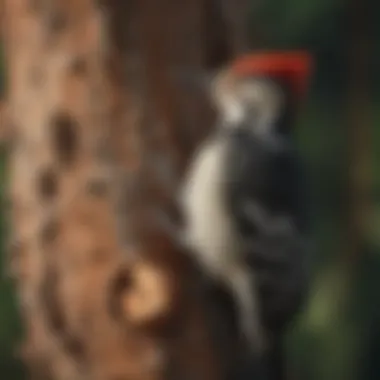
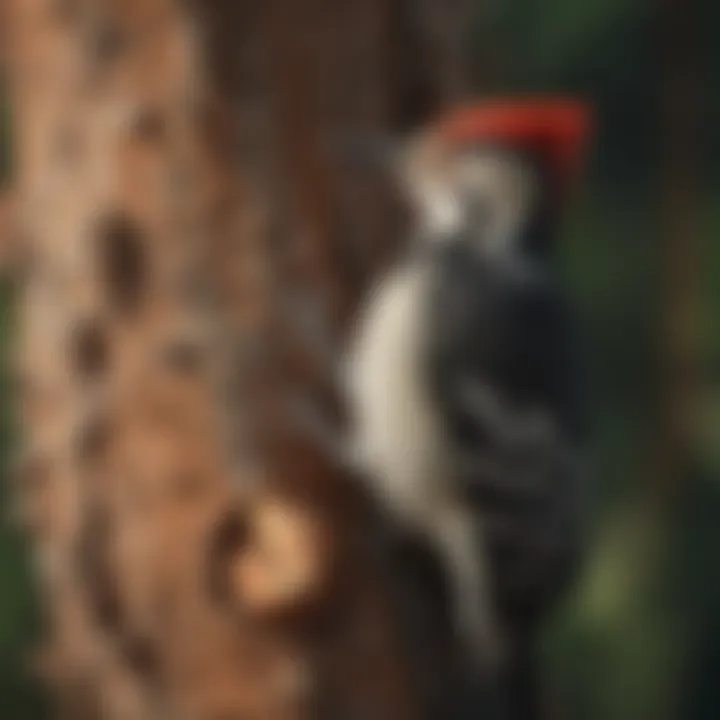
Red-Headed Woodpecker
The Red-Headed Woodpecker is distinguished by its vibrant red head and contrasting black and white body. It prefers open woodlands and is known for its unique foraging behavior that includes catching insects mid-flight. This species demonstrates a significant ecological role by controlling insect populations and creating natural cavities in trees that serve as homes for other wildlife. The declining numbers of the Red-Headed Woodpecker in some areas raise concerns about habitat loss and competition, highlighting the need for targeted conservation strategies.
"The diversity of woodpeckers serves as an indicator of forest health and biodiversity."
In summary, the taxonomy and diversity of woodpeckers elucidate their ecological roles and the challenges they face. Understanding these aspects is fundamental to the conservation of woodpecker populations across North America.
Physical Characteristics of Woodpeckers
Understanding the physical characteristics of woodpeckers is fundamental to appreciating their adaptation to diverse environments across North America. This section discusses how their physical traits are vital for their survival and ecological roles. The unique anatomy of woodpeckers aids in their behaviors and in their contributions to the ecosystem.
Size and Plumage
Woodpeckers exhibit a range of sizes, which often correlate with their habitat and dietary needs. Generally, their size can vary from the tiny Downy Woodpecker, around 6.5 inches long, to the much larger Pileated Woodpecker, which can measure up to 19 inches. This diversity in size allows them to occupy various niches in forest ecosystems.
Plumage is another key characteristic that serves multiple functions. The feathers of woodpeckers are not only aesthetically pleasing but also serve as protective features against environmental elements. Their colors, such as the striking crimson of the Red-Headed Woodpecker and the black-and-white markings of the Downy Woodpecker, often contribute to their camouflage against predators or aid in mating rituals.
Adaptations for Drilling
Woodpeckers have evolved specific adaptations that enable them to drill into trees, which is essential for foraging and nesting. These adaptations include strong beaks and claws that facilitate their unique feeding and nesting behaviors.
Strong Beaks and Claws
The beak of a woodpecker is a remarkable feature. It is typically long, strong, and chisel-shaped, allowing the bird to penetrate hard wood. This characteristic makes it effective at extracting insects from beneath the bark, which is a primary source of nutrition. Additionally, their claws are sharp and designed for gripping onto the tree bark securely, preventing slips during their vigorous drilling activities.
The robustness of these beaks and claws also reflects the woodpecker's feeding strategies. The ability to forage on various tree species enhances their adaptability to different habitats. A well-developed beak is not just advantageous but essential for survival.
Shock-Absorbing Skulls
Another fascinating adaptation is the structure of woodpeckers' skulls. These birds possess specialized shock-absorbing skull features that protect their brains while they drum against trees. The internal design of their skulls helps manage the intense force generated during drilling, reducing the risk of injury.
The shock-absorption capacity of the skull is crucial, as it enables woodpeckers to maintain their foraging habits without detrimental effects on their health. This unique feature illustrates the evolution of woodpeckers as they adapted their physiology to withstand the physical demands of drilling into tough substrates.
"The intricate adaptations of woodpeckers not only highlight their evolutionary success but also underscore their ecological significance in forest environments."
Behavioral Patterns of Woodpeckers
Understanding the behavioral patterns of woodpeckers is critical in appreciating their role within ecosystems. Their actions are finely tuned to their habitats and the resources available. Observing these behaviors provides insight into their adaptations and survival strategies. It’s also essential for conservation efforts as it helps to monitor and protect these species.
Feeding Habits
Nutrition Sources
Nutrition is key to the survival of woodpeckers. They primarily feed on insects, particularly wood-boring beetles and ants. This insectivorous diet allows them to thrive in various habitats, from forests to urban areas. Another important food source is tree sap, which they extract from trees using their specialized tongues.
- Key Characteristics: Insects provide high protein content which woodpeckers need. Sap offers quick energy.
- Advantages: A diverse diet allows adaptation to different environments. It also makes them essential in controlling insect populations, benefiting forest health.
- Disadvantages: Dependency on specific food sources can be detrimental if those sources dwindle due to habitat loss or climate change.
Techniques for Foraging
Woodpeckers employ distinct techniques for foraging. They use pecking to excavate wood, revealing hidden insects. This technique is advantageous in their search for food.
- Key Characteristics: Their strong beaks and unique skull structure enable efficient drilling.
- Advantages: Effective foraging techniques allow them to access food sources that many other birds cannot.
- Disadvantages: These strategies require significant energy, especially if food availability decreases.
Mating and Nesting Rituals
Mating behaviors are intricate and vary among species. Woodpeckers often engage in drumming as part of courtship rituals. These displays not only attract mates but also establish territory. Nesting behavior follows, where woodpeckers select suitable sites and materials.
Nesting Sites and Materials
Nesting sites are selected based on safety from predators and proximity to food sources. Woodpeckers often choose decaying trees, which provide natural cavities. They also use wood chips or bark as nesting materials.
- Key Characteristics: Natural cavities afford protection and are crucial for hatchling survival.
- Advantages: The use of decayed trees aligns with their ecological role in tree decomposition.
- Disadvantages: A shortage of decayed trees due to logging or disease can reduce suitable nesting options.
Role of Parental Care
Parental care among woodpeckers typically involves both parents in feeding and protecting the young. This cooperation increases the survival rate of chicks and strengthens pair bonds.
- Key Characteristics: Shared responsibilities ensure constant care and nutrition for chicks.
- Advantages: Higher chick survival rates lead to more successful breeding seasons.
- Disadvantages: Parents may experience stress if food is scarce, affecting their ability to care for the young adequately.
"Observing the mating and nesting behaviors of woodpeckers is essential for understanding their ecological significance and for fostering effective conservation strategies."
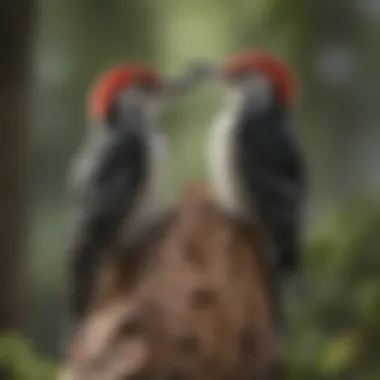
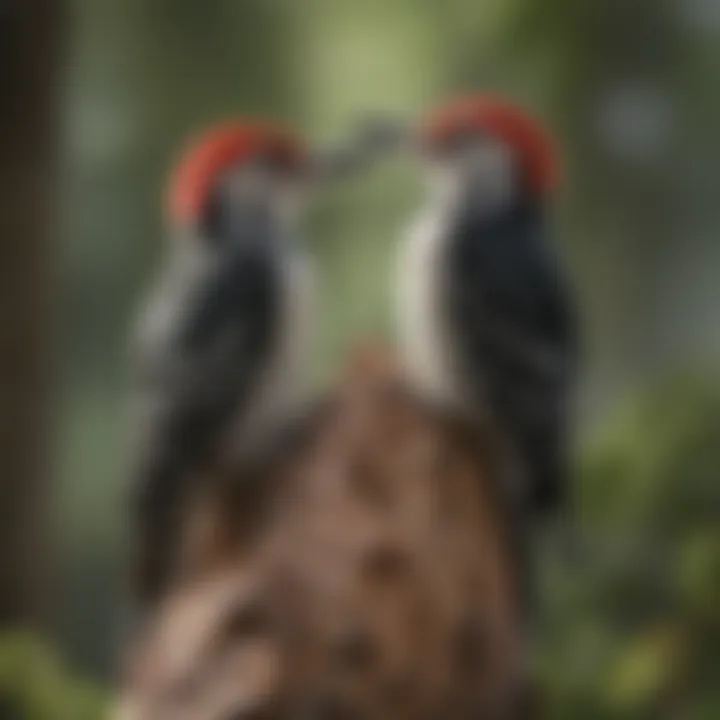
Through studying these behavioral patterns, conservationists and researchers can formulate better strategies to protect and manage woodpecker populations effectively.
Habitat Preferences and Distribution
Understanding the habitat preferences and distribution of North American woodpeckers is crucial for their conservation and ecological significance. Woodpeckers are highly specialized birds that rely on specific environments for foraging, nesting, and breeding. By examining their habitat choices, we can identify key areas that need protection and understand how changes in land use affect these species. Additionally, these habitats provide insight into the ecological roles woodpeckers play in maintaining forest health and pest control.
Types of Ecosystems
Forests
Forests are a primary habitat for many woodpecker species. These environments are characterized by dense trees, which provide ample food sources and nesting sites. Woodpeckers, such as the Downy Woodpecker, find food in the form of insects and larvae hiding within bark.
The vertical structure of forests allows woodpeckers to forage at different heights, enabling them to exploit various food sources. Furthermore, the presence of dead or decaying trees is essential. They create opportunities for nesting and provide habitats for other insects, which in turn sustains the woodpecker population.
Advantages of forests include their diverse ecosystems and the range of resources they offer. However, forests face threats from logging and urbanization, which can significantly reduce available habitat.
Woodlots
Woodlots are smaller, often fragmented patches of forest that serve as habitat for woodpeckers. These areas are important, especially for species like the Red-Headed Woodpecker. Woodlots may not provide the same resources as expansive forests but can support healthy populations if managed correctly.
The key characteristic of woodlots is their accessibility to human populations, allowing for multiple forms of land use. They are often overlooked in conservation efforts, but they play a vital role in the landscape. One advantage is their ability to connect larger habitats, creating corridors for wildlife.
However, woodlots face the risk of isolation, making it hard for woodpeckers to find mates and resources, thus contributing to vulnerabilities in small populations.
Urban Areas
Urban areas present a unique habitat for woodpeckers. Many species have adapted to city environments, finding food and nesting opportunities in parks and landscaped areas. For instance, the Pileated Woodpecker can often be spotted in urban green spaces where there is sufficient tree cover.
The unique feature of urban areas is their contrast to natural environments. They may provide unexpected nesting sites, such as old trees in backyards or wooden structures. Moreover, the human presence often brings awareness to conservation efforts, promoting the preservation of these green spaces.
However, urban areas can also pose challenges. The risks include hazards such as traffic, pollution, and reduced food availability as native species decline. Therefore, while urban areas can be beneficial to some extent, careful planning and conservation efforts are necessary to mitigate negative impacts.
Geographical Range
The geographical range of woodpeckers in North America varies broadly among species. Generally, woodpeckers thrive from southern Canada down to northern Mexico. Their distribution depends significantly on the availability of suitable habitats. Factors such as climate and elevation also influence where woodpeckers can successfully reside.
Understanding this geographical distribution is essential for targeted conservation efforts. Conservationists can aim to protect specific regions that serve as vital habitats for particular species. Monitoring the changes in ranges and populations provides data critical for determining the overall health of woodpecker species in North America.
"Protecting habitat is paramount for the survival of woodpecker populations and maintaining biodiversity."
Ecological Importance of Woodpeckers
Woodpeckers play a vital role in maintaining the ecological balance of forest habitats. Their unique behaviors and feeding habits contribute significantly to pest control and the overall health of forest ecosystems. Understanding their ecological importance aids in appreciating their value beyond mere aesthetics.
The impact of woodpeckers on their environment extends from controlling pest populations to creating habitats for other creatures. By drilling into trees, woodpeckers not only extract insects but also facilitate the decay of wood, which in turn benefits the forest ecosystem. Their activities can create cavities that serve as nests for various bird species and small mammals. Thus, woodpeckers are considered essential components of forest dynamics.
Role in Pest Control
Woodpeckers are effective predators of harmful insects, such as bark beetles and wood-boring beetles. Their foraging methods typically involve tapping into tree bark and pecking into wood to access underlying larvae. This behavior helps in managing pest outbreaks, which can otherwise devastate tree populations.
Research has shown that the presence of woodpeckers can lead to reduced insect populations, benefiting not just the trees but also other wildlife dependent on healthy trees for survival. Their feeding habits ensure that the ecosystems remain balanced, reducing the reliance on pesticides, which can have negative effects on both the environment and human health.
"The role of woodpeckers in pest control is a natural form of biological control, essential for maintaining forest health."
Ecosystem Engineers
Woodpeckers can be classified as ecosystem engineers. They alter and maintain their habitat through physical modifications. When woodpeckers excavate cavities into trees for shelter and nesting, they inadvertently create opportunities for other species. Many birds, including bluebirds and chickadees, utilize abandoned woodpecker holes as nesting sites.
Furthermore, the act of drilling also aids in the decomposition process. As woodpeckers create openings in bark, they facilitate the entry of fungi and microorganisms that break down dead and dying trees. This process enhances soil nutrient cycling, encouraging the growth of new plants and supporting a diverse range of flora and fauna.
In summary, woodpeckers are not just inhabitants of forests but vital actors. Their ecological contributions, from pest control to creating habitats, underscore the need for Conservation Strategies to protect these birds and their habitats.
Threats to Woodpecker Populations
Understanding the threats to woodpecker populations is essential for recognizing the broader issues concerning biodiversity and ecosystem health. Woodpeckers are not only fascinating creatures but also play pivotal roles in their habitats. They help control insect populations and create nesting sites for other wildlife through their drilling activities. However, many factors threaten their survival.
Habitat Destruction
Habitat destruction is one of the most significant challenges faced by woodpecker populations. Urbanization, logging, and agricultural expansion result in the loss of critical forested areas. These activities fragment habitats, making it difficult for woodpeckers to find suitable nesting sites and access food resources.
- Increased development leads to decreased tree cover.
- logging practices can remove old trees which are vital for woodpeckers.
- Fragmented habitats may isolate populations, reducing genetic diversity.
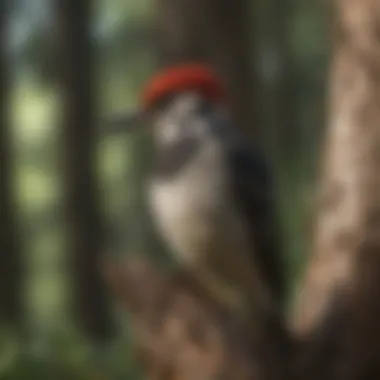
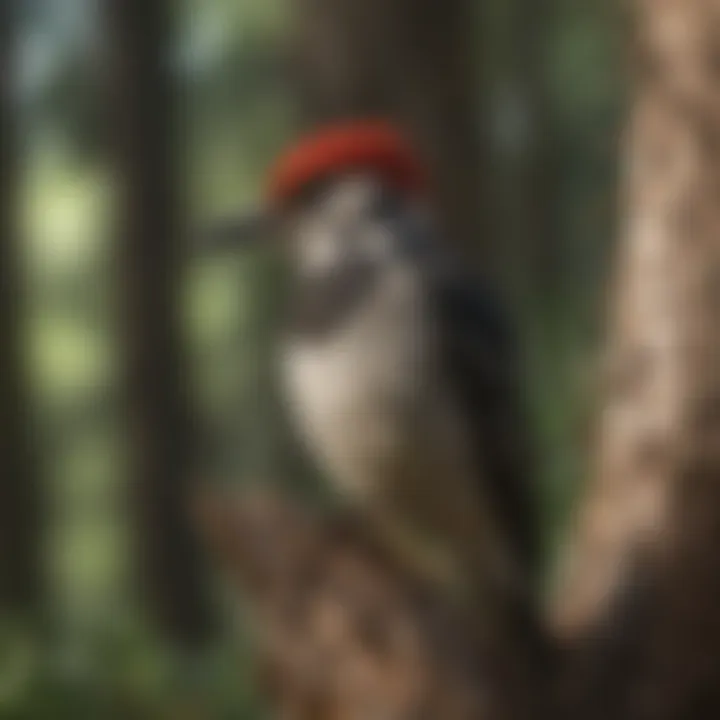
These changes have direct consequences for species such as the Red-Headed Woodpecker, which relies heavily on mature forests. Protecting existing habitats and restoring degraded areas is crucial for their survival.
Climate Change Impacts
Climate change poses an emerging threat to woodpecker populations. Altered weather patterns can shift the distribution of their food sources, such as insects and sap from trees, affecting their foraging habits. Changes in temperature and precipitation levels can also lead to habitat shifts, impacting tree growth and health.
- Increased temperatures can influence migration patterns.
- Extreme weather events can destroy nests and reduce food availability.
The impact is particularly notable for species adapted to specific climatic conditions, making it imperative to monitor how these adaptations may influence their populations over time.
Competition with Other Species
Competition with other species further complicates the survival of woodpeckers. As habitats change and resources become scarcer, woodpeckers may find themselves competing with other bird species for nesting sites and food. In some cases, invasive species may outcompete native woodpeckers for limited resources.
- Invasive species may alter the ecosystem, reducing food availability.
- Native woodpeckers may struggle against larger species for nesting sites.
Such interspecies competition can put additional strain on already vulnerable woodpecker populations, making conservation efforts increasingly important to maintain ecosystem balance.
Conservation Efforts and Strategies
Conservation efforts and strategies for North American woodpeckers are critical in ensuring the survival of these unique birds. With their specific habitat requirements and ecological roles, woodpeckers are sensitive to environmental changes. Thus, targeted conservation measures are necessary to mitigate the risks they face.
One key benefit of effective conservation strategies is the maintenance of biodiversity within forest ecosystems. Woodpeckers contribute to pest control and create cavities that other species can use for nesting. Protecting their populations indirectly supports numerous other wildlife species, enhancing overall ecosystem health.
Protected Areas and Reserves
Protected areas and reserves are crucial for the conservation of woodpeckers. These regions, such as national parks and wildlife refuges, serve as safe havens where woodpeckers can thrive without the pressure of habitat destruction or human interference. For example, places like the Great Smoky Mountains National Park offer ample habitats for various woodpecker species.
The establishment and proper management of these protected areas are essential. Regular monitoring ensures they provide adequate resources such as food and nesting sites. Additionally, education about these protected areas fosters a sense of responsibility among visitors, promoting conservation efforts.
Community Involvement Initiatives
Community involvement initiatives play a vital role in woodpecker conservation. Local communities can engage in species monitoring programs, habitat restoration projects, and educational campaigns. Collaboration with conservation organizations enables individuals to contribute directly to preserving local biodiversity.
For example, citizen science projects often empower volunteers to help gather data on woodpecker populations. This not only enriches scientific knowledge but also raises awareness about the necessity of conservation efforts. Moreover, supporting local conservation initiatives instills a greater appreciation for the natural world among community members.
Legislation and Policy Frameworks
Legislation and policy frameworks provide the backbone for conservation efforts targeting woodpeckers. These policies establish guidelines for habitat protection, promote sustainable land use practices, and ensure funding for conservation programs. Effective legislation, such as the Migratory Bird Treaty Act, offers critical protection to woodpeckers during their migratory periods.
It is essential to continually advocate for strong policies that address emerging threats, like climate change and habitat fragmentation. By collaborating with policymakers, conservationists can drive the necessary legislative changes to safeguard woodpecker populations. Furthermore, raising public awareness about these policies helps garner support for their implementation.
"Conservation is a state of harmony between men and land." - Aldo Leopold
Research and Monitoring of Woodpecker Populations
The study of North American woodpecker populations is crucial for understanding their ecological roles and the challenges they face. Research in this area informs conservation strategies and enhances our comprehension of the species' distribution, behavior, and habitat preferences. Monitoring woodpecker populations allows conservationists and researchers to identify trends, assess the impact of environmental changes, and implement effective protection measures.
Population monitoring can facilitate the early detection of declines in woodpecker numbers. This information is important as many species are indicators of forest health. Loss of woodpeckers can signify broader environmental issues. Thus, regular observation equips conservationists with the tools to act before species reach critical levels.
Another aspect of monitoring involves understanding the breeding success and survival rates of various woodpecker species. By analyzing data on nesting sites and chick development, researchers can determine factors influencing these metrics. Such insight is valuable as it can guide habitat management and protection measures. Furthermore, collaborating with local communities enhances monitoring efforts and fosters a sense of stewardship toward these birds and their habitats.
Methods of Population Monitoring
Accurate population monitoring of woodpeckers employs various methodologies to gather reliable data.
- Point Counts: One common method involves point counts, where observers record the number of woodpecker calls or sightings in a specific area over a set period. This method is simple but effective for estimating population sizes and distributions.
- Nest Surveys: Researchers locate and monitor nesting sites to assess reproductive success. By observing the number of eggs laid and chicks fledging, they can gauge the health of the population.
- Banding Programs: Banding individuals allows for tracking movements, survival rates, and longevity. Such information can reveal migration patterns and site fidelity.
- Citizen Science: Involving the public in data collection broadens the reach of monitoring efforts. Apps and online platforms enable citizen scientists to report sightings, contributing valuable information while raising awareness.
These methods, combined with technological advancements like camera traps and bioacoustic monitoring, improve data collection efficiency and accuracy.
Recent Findings in Woodpecker Research
Recent research on woodpecker populations has yielded significant discoveries.
- Habitat Preferences: Studies indicate that woodpeckers exhibit specific habitat preferences linked to the availability of food and nesting sites. Forests with a mix of old and young trees support a higher diversity of woodpecker species.
- Impact of Climate Change: Research also highlights how climate change affects woodpecker distribution. As temperatures rise and weather patterns change, certain species are shifting their ranges. For instance, some woodpecker species are moving northward to track suitable habitats.
- Behavioral Insights: Acoustic studies have unveiled intricate mating calls and drumming patterns used by different woodpecker species. These findings enhance our understanding of social dynamics and communication.
- Conservation Outcomes: Evaluations of conservation initiatives show positive outcomes in areas where habitats are restored or protected. Increased woodpecker populations in these regions demonstrate the efficacy of targeted conservation efforts.
Overall, ongoing research plays a pivotal role in informing future conservation strategies. Continued monitoring and knowledge share among researchers, conservationists, and communities will uphold the health of woodpecker populations in North America.
The End: The Future of North American Woodpeckers
The conservation status of North American woodpeckers is a topic of increasing relevance. As environmental changes accelerate, understanding the future of these birds becomes essential. Woodpeckers play a pivotal role in maintaining healthy ecosystems. Their presence indicates the well-being of forest habitats. Without them, pest populations could surge, leading to ecological imbalance.
Implementing effective conservation strategies is crucial. Protected areas, for example, help safeguard the habitats of these birds. Reserves allow populations to thrive, free from human interference. Additionally, community involvement initiatives are vital for raising awareness. When local people engage in woodpecker conservation, they help protect not only the birds but also the habitats they rely on.
Legislation must also adapt to these changing times. Policies should reflect the latest scientific research on woodpecker populations. By integrating findings from ongoing studies, legislation can be more effective.
Investing in research enhances our understanding of these species. Monitoring methods, such as banding and citizen science, have shown promise. Recent studies reveal intriguing behaviors and population dynamics. These insights aid in tailoring conservation efforts to meet specific needs.
In summary, the future of North American woodpeckers hinges on robust conservation actions. Collaborative efforts among researchers, policymakers, and the public are essential. Their fate is intertwined with the health of our forests. Thus, nurturing woodpecker populations is not just about saving a species; it's about preserving our natural heritage.



